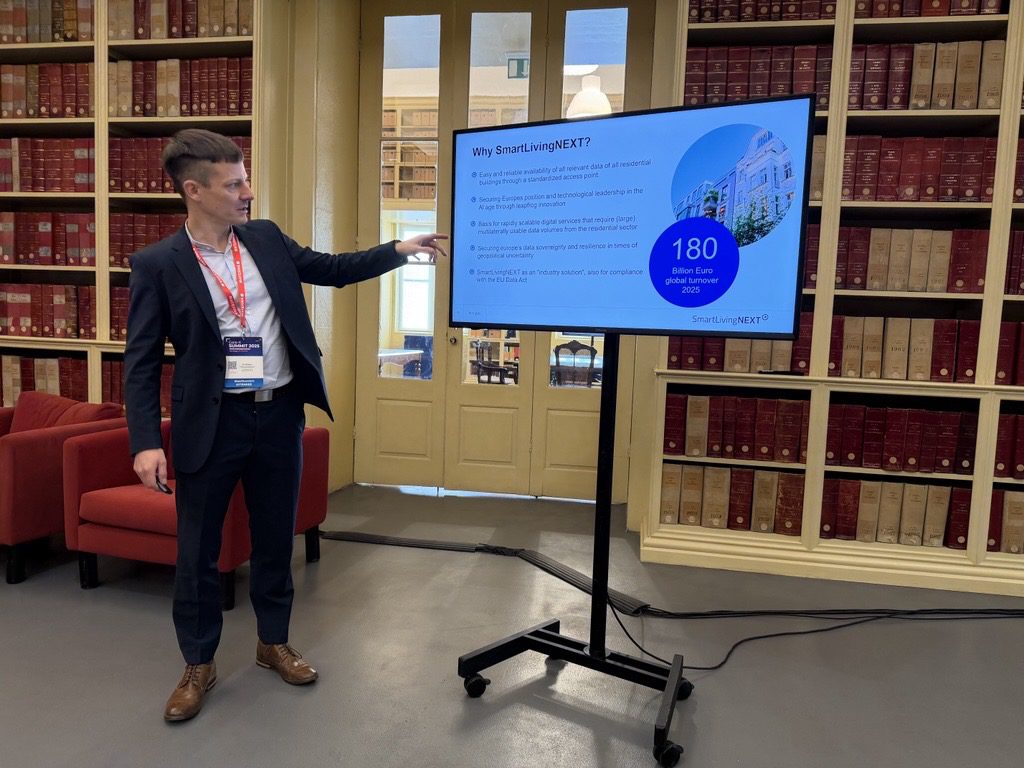SmartLivingNEXT presents itself at the Hightech Summit in Frankfurt.
27. May 2024
5 minutes
“Back to the Microtechnology Future: Yesterday’s Visions, Tomorrow’s Realities.” – was the title of the second Hightech Summit, which took place on May 7 and 8, 2024 at the German Film Institute in Frankfurt am Main. SmartLivingNEXT presented itself from three interesting angles with one presentation each on its strategic importance, its dataspace concept and an example of implementation with the ExpliCareNEXT project.

From visionary space research and effective automation processes to intelligent buildings – at this year’s Hightech Summit, visitors were able to immerse themselves in a wealth of exciting innovation topics. Experts and filmmakers answered the key question “What used to be fantasy and is already reality today?” by combining excerpts from science fiction films with presentations on current technologies. During the two days of the event, a total of eight different sessions and two workshops invited participants to listen and join in the discussions. Under the session title “From sci-fi to reality – how the smart home is changing the way we live”, three experts explained the SmartLivingNEXT research approach.
Strategic importance of SmartLivingNEXT
Michael Schidlack from the Research Association for Electrical Engineering at ZVEI e. V. and head of the SmartLivingNEXT flagship project kicked things off. He presented the vision of the technology program funded by the German Federal Ministry for Economic Affairs and Climate Action (BMWK): a simple and secure data access point for various applications and for all types of building automation systems and sensors. This creates a smart living ecosystem that allows applications to be developed quickly and cost-effectively. According to Schidlack, this has several advantages. Manufacturers can implement their products in technically heterogeneous buildings while at the same time meeting the requirements of EU data protection law. SmartLivingNEXT enables the housing industry to use a cost-effective range of digital services for the entire building portfolio. “Last but not least, SmartLivingNEXT also offers an alternative to previous platform models in which one dominant player absorbs a large part of the value creation,” Michael Schidlack concluded his presentation by pointing out that further information on this can be found in the SmartLivingNEXT white paper, which can be ordered from the project office.
SmartLivingNEXT Dataspace: the basis for intelligent, interconnected buildings
In the second part of the session, Dr. Hilko Hoffmann from the German Research Center for Artificial Intelligence (DFKI) explained how this vision could become reality in the not too distant future. SmartLivingNEXT is researching the transition from a building automation level in which smart components, devices and systems are networked with each other with time-limited flexible self-regulation to a fully automated and AI-based automation level in which all relevant functionalities are digitally networked and selected functions are self-regulating and self-learning.
This requires data that comes from various cloud, smart home or test systems in the technology program. They are summarized in the SmartLivingNEXT Dataspace. The special thing about this is that the data can be left in its original environment thanks to specific interfaces and the semantic data space concept. This allows data to be shared while the respective market partners can retain control over it. The dataspace concept developed in the flagship project can be used by other SmartLivingNEXT projects for their own applications and services. In this context, various services, some of which are AI-based, are also provided – similar to a modular system – to make it easier for developers to program the specific applications.
ExpliCareNEXT: Support for unskilled home care workers
ExpliCareNEXT provides a highly relevant example of implementation that addresses the nursing care crisis in Germany. It is one of seven projects researching AI-based, sustainable living and residential environments as part of the SmartLivingNEXT technology program. At the heart of this is the simplification of care processes through artificial assistance, which enables unskilled home care workers to carry out high-quality care activities.
Prof. Edwin Naroska from the Niederrhein University of Applied Sciences explained to the audience how it works. In a smart home, the assistance system to be developed can generate various options for action and instructions through voice interaction and situation recognition in home care. This requires data to be aggregated and analyzed in a short time. ExpliCareNEXT will be based on the SmartLivingNEXT Dataspace and will be compatible with other Gaia-X-compliant ecosystems. Application partners can use the system to ensure the quality of care and support, to compensate for a lack of nursing staff and for greater efficiency in organizational processes.
The Hightech Summit 2024 was a cinematic event with excerpts from science fiction films from various decades, which made an impressive connection to innovation topics of our time. Research programs such as SmartLivingNEXT show how the home of the future could be transformed by self-learning AI-based services.
Listen to the article (in German)
Editorial office:
Maximilian
Metzner
Category:
ExpliCareNEXT




